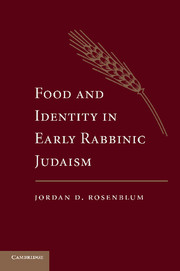4 - Jewish Male Rabbinic Identity
Published online by Cambridge University Press: 06 July 2010
Summary
The [European Jews'] encounter with food in America in the context of novelty and abundance also subverted a culture built around food taboos. Food, so central to the Judaic sacred system and the promise of America, got caught up in a complicated set of internal Jewish fights about class, immigrant status, religion, generation, and gender. Because they venerated food, and because so much about their food world changed in America, it became a locus of contestations and conflict.
In the epigraph to this chapter, Hasia Diner discusses how various factors contribute to food becoming a “locus of contestations and conflict” between European Jews who immigrated to America. This is by no means a modern phenomenon. Just as the Tannaim use culinary and commensal practices to establish distinct Jewish and male identities, so too did these practices serve to establish a Jewish, male, and rabbinic identity. In fact, the Tannaim devote more attention to parsing how their culinary and commensal practices distinguish themselves from other Jews than they do to any other “Other.”
The Tannaim construct their Jewish, male, rabbinic identity in part by way of four food practices. First, they develop the notion that there is a distinctive cuisine that comprises the diet and foodway of (and, thus, marks the socially constructed identity of) a rabbinic Jew. (Throughout this book, the term “rabbinic Jew” refers to a Jew who chooses to follow the prescriptions of rabbinic Judaism, as opposed to a nonrabbinic Jew, who, although unquestionably Jewish even in the eyes of rabbinic Judaism, has chosen not to adhere to rabbinic practice.)
- Type
- Chapter
- Information
- Food and Identity in Early Rabbinic Judaism , pp. 138 - 184Publisher: Cambridge University PressPrint publication year: 2010



